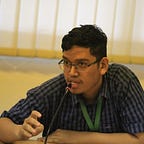Ascension, Arts, and Religious Truths
Today, March 22nd, is Isra’ and Mi’raj, the commemoration of Prophet Muhammad’s (pbuh) famous Night Journey and Ascension to the heavens that is celebrated by Islamic communities. Indonesia itself observes this day as one of the religious holidays, just like Eid al-Fitr and Eid al-Qurban, which are celebrated nationally. By “celebrated”, yes, it is a national public holiday and people don’t go to school or work, despite not being a ‘legitimate’ Islamic holiday (no special rituals whatsoever).
While not being a religious person, to some extent, I feel a cultural affinity with Islam. I live by some of its philosophy and values. However, being an art enthusiast, I am not really content with the community’s attitude towards the arts in general, at least in Indonesia where I live. Of course, some arts, such as nasheed and calligraphy, are accepted and incorporated into its festivities and teachings, but sculptures and paintings? Not so much, even less so during Isra’ and Mi’raj.
In retrospect, having received extensive Islamic education in my childhood, I now realize that it was normative and monotonous when the young me studied the lesson Sejarah Kebudayaan Islam (Islamic Cultural History). It was ironic that it felt more of a history lesson than a cultural one. Almost everything was either reading texts or listening to lectures, from the birth of Muhammad to the Islamic Caliphates. I envy how Christian communities teach their history and arts hand-in-hand; for any Biblical story, you can bet that some Renaissance artists painted that already.
I mean, how come thas as Muslims, we know more about this painting:
and this painting:
but we have no idea who painted this and what this is about?
Answer: The painting (more precisely, miniature painting) depicted the Ascension of Muhammad (center of the picture) who rode Buraq (the winged horse) surrounded by angels. It’s a Persian painting (you can tell by the inscriptions) but if you thought it had some Chinese influence, you’re not wrong.
Basically, what I am writing here ties to the Persian miniature painting, something I myself just found out about two years ago. It was a significant genre of Persian art adopted from the Chinese culture after the Mongol invasion in the 13th century, usually made to illustrate works of literature, such as poetry and the like. As a Muslim, I was really pissed off that I did not know any of this earlier when I was in school.
That was my first point. Imagine if the learners, especially young ones, could know that at a certain point in Islamic history, we did LOTS of art? Classes could be definitely more entertaining and lively, as students could listen to the story of Prophet Joseph and Potiphar’s wife while looking at this beautiful piece of art:
(Teachers, this is a mother lode for your teaching resources!)
Secondly, I believe that it is important to embrace alternative versions of religious truths. How do we expect the future generation to accept differences, if they did not know any of them in the first place? I mean, did you know that Muhammad encountered a rooster angel (I kid you not) during the Ascension? Now you do.
Quran tells very little of the journey, save for the first verse of the chapter Al Isra (The Night Journey). That leaves the large remaining of the story open to interpretation. Hadith and the narratives from the companions of the Prophet did clear some details (e.g. the instruction to daily prayers), but frankly, there is not a single consensus over the complete events of what happened that night. Delving into multiple resources could benefit us with the enrichment of the narrative.
Finally, my last point: controlling the narrative. I get it that the idea of painting live creatures is frowned upon by some schools of fiqh. Drawing or showing the image of prophets could even be considered blasphemy. However, I have to assert that refraining from producing anything never stopped other parties to do the same, especially those with malicious intents. Take Jyllands-Posten’s infamous caricature, for example. If Muhammad’s life and journey were illustrated either way, wouldn’t we want the Muslims themselves to be in charge?
At least, if Muslim scholars were to welcome visual arts and films to be integrated with Islamic teachings, that would at least help us claim our revered figures and fight back the negative propaganda. By taking control of the narrative, we can project Islam to the world in manners that we approve.
Khoda Hafez,
Muhammad Hafidh
